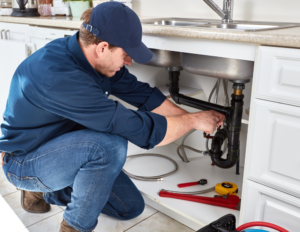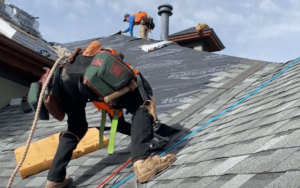Plumbers Wilkes Barre PA install, repair and maintain the pipes and fixtures that provide water, gas and waste disposal in homes and businesses. This critical trade requires strong analytical thinking and problem-solving skills.
Plumbing also involves heavy lifting and working in tight spaces. Physical strength and stamina along with manual dexterity are important for success in this career.

Whether it’s for residential or commercial properties, the water supply line is vital for the proper operation of plumbing fixtures. It also provides potable water for the building’s occupants. This drinking water line needs adequate inspections and maintenance from professional plumbers to minimize wastage or contamination. It should also be free from cross-piping with other systems that could transmit contaminants. The plumbing materials on the water supply line should meet performance and quality specifications set by authorities or accepted certification organizations.
The water line is connected directly to a public main water distribution line, and it then leads to the home’s water heater. From there, it divides into hot and cold water lines that connect to all the faucets, showers, and toilets inside the house. The line is usually installed in a gridiron pattern so that any damaged pipes can be easily isolated and repaired without interrupting the entire system.
Plumbing contractors typically use PEX tubing for these supply lines because it’s durable and affordable. It’s also flexible, so fewer elbows and other fittings are required during installation. This makes the system easier to maintain and repair.
The plumbing contractor also installs a water meter and shutoff valve at the main water supply line to record the building’s water usage for billing purposes. The valve should be located at the base of every water riser pipe in occupancies two stories or less in height, and it should be on top of each water down-feed pipe in one-story and two-family residential occupancies. In addition to the main water shutoff valve, each fixture should have individual stop valves for emergencies. A plumber should be present during the planning stage to make sure that the design and construction of the pipings are safe and practical.
Waste Disposal
A garbage disposal is an appliance that’s installed beneath a kitchen sink to help you quickly and easily get rid of food scraps. It uses a motor to shred the scraps into small enough pieces that they can easily pass through your plumbing and sewer or septic system. A garbage disposal will also help prevent clogged drains by keeping unwanted particles from going down the drain. However, it is important to know what types of waste are safe to put down your disposal and which ones are not.
A good rule of thumb is to avoid putting any food that can’t be broken down by your disposal’s blades into your waste disposal unit. This includes stringy foods like celery, artichokes and asparagus stalks, rice (it tends to expand when wet) and pasta. Also, fats and oils should never go down a disposal, as they can congest your pipes and cause bad odors.
It is recommended that you clean your disposal once a week. This can be done by pouring a mixture of half baking soda and half vinegar down the disposal, followed by some water. This will clear away any built-up grime and eliminate odors. It is also a good idea to turn on the disposal and run it for about 30 seconds after doing this.
If you are considering installing a garbage disposal in your home, it’s best to hire a plumber to do the job. They will have the knowledge and experience to install the disposal correctly, connect it to your plumbing and make sure all the electrical work is done properly. This will save you both time and money in the long run.
A plumber may also be able to help you determine if you need a septic tank or other alternative waste disposal method. A septic tank is a large concrete or fiberglass tank that sits on top of the ground and treats waste through anaerobic bacteria. A cesspool is a similar but less expensive option, as it works in a similar way to a septic tank but doesn’t require extra pumping.
Hot Water
Plumbers are frequently called upon to fix issues with hot water systems. When a water heater is not heating or producing enough hot water, it’s often a sign that the anode rod needs to be replaced or there is corrosion in the tank. Other problems with hot water may be caused by an unbalanced pressure system that can rupture pipes, valves or the water heater itself. Plumbers are expertly trained to diagnose these issues and repair them as needed.
Plumbing Impacts Lives
Modern plumbing has been a lifeline for many people around the world. In fact, it is estimated that it actively saves millions of lives each year. Without the development of plumbing, diseases such as dysentery, cholera, typhoid fever, E coli and other water-borne illnesses would have decimated populations. Today, a well-functioning plumbing system is critical for ensuring that clean drinking water flows to every household and that wastewater is properly treated and safely transported away from cities and towns.
Plumbers are vital to maintaining a functioning society, as they install and repair all of the water, drainage, waste and gas piping that keeps homes and businesses safe and comfortable. They are also responsible for establishing water conservation strategies and educating the public on how to minimize their environmental impact through simple practices such as shutting off the faucet while brushing teeth or taking short showers.
As such, plumbing is considered a “recession-proof” career, as demand for the profession increases even during economic downturns. Moreover, because the installation, maintenance and repairs that plumbers conduct cannot be automated, they are not likely to be out of work anytime soon.
Lastly, plumbing provides a high level of job satisfaction and offers excellent pay. Licensed plumbers may choose to work for a large company as an employee or strike out on their own as independent contractors. Most learn the trade through vocational schools or as apprentices assisting licensed plumbers, and they can often earn a good living with no student debt.
The physical demands of the job can be intense at times, but it’s a great way to stay in shape. Plumbers regularly bend, crouch and squeeze into tight spaces, and they must have strong upper body strength to operate power tools. As a result, it’s not uncommon for plumbers to develop back problems.
In addition to the physical requirements of the job, plumbers must be competent at math and have good analytical thinking skills. They must also adhere to building codes and regulations, which are set by each province or territory. Lastly, plumbers must be able to communicate effectively with clients and other professionals.
Troubleshooting
When a home plumbing problem occurs, it is important to take prompt action. Otherwise, the problem could worsen and lead to costly repair bills. Many plumbers have experience in troubleshooting and can diagnose issues before they become serious. However, sometimes troubleshooting requires more than just looking at a pipe or faucet. Observing other symptoms in the house can help identify the cause of the problem. These clues can help a homeowner save time and money by preventing unnecessary trips to the plumber.
Leaky pipes are one of the most common plumbing problems. They can cause high water bills, damage wood and masonry, create breeding grounds for bacteria and cockroaches and may lead to expensive repairs. Leaky toilets are also problematic and may cause significant damage to the structure of a home or the surrounding area. This type of problem is easy to fix with some basic tools and the right know-how.
Another common problem is clogged drains. These can be caused by hair, dental floss, food waste or other debris. Depending on the severity, a homeowner can try using a drain snake or plunger. In severe cases, a sewer system backup or septic tank problem might be the culprit. This is a more serious issue that needs to be handled by a professional.
In some instances, a commercial plumbing problem may require the services of a licensed plumber. This can be due to complex issues that involve gas or other specialized equipment. However, many problems can be prevented through regular inspections and maintenance. Promoting responsible use of the plumbing systems in a business can also go a long way toward reducing the need for plumbers. For example, educating employees on what can and cannot be flushed in the toilets can help prevent blockages and other problems. When the unexpected happens, these simple troubleshooting tips can help a business owner get back on track quickly.
Customer Service
Providing superior customer service is key to a plumbing business’s success. Plumbers who prioritize this aspect of their business build trust and loyalty with customers, which ultimately leads to more sales. In addition, plumbers who focus on customer service are more likely to receive positive online reviews that can boost their reputation and grow their business.






